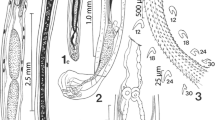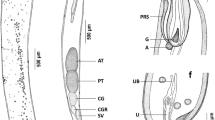Abstract
Acanthocephalans of the family Polymorphidae Meyer, 1931 are cosmopolitan parasites that infect the intestines of fish-eating birds and mammals. Polymorphid acanthocephalans recovered from the intestines of red-billed gulls (Chroicocephalus scopulinus (Forster)) from the Otago coast, New Zealand, although morphologically similar to the genus Arhythmorhynchus Lühe, 1911 nevertheless have a unique molecular profile showing considerable genetic differentation, and are here diagnosed and described as Tenuisoma tarapungi n. g., n. sp. Characters which distinguish T. tarapungi include a very elongate, cylindrical hindtrunk, swollen anterior trunk with a spinose region, a secondary swelling in males only containing the testes, and hypodermal nuclei distributed throughout the length of the trunk. Molecular data (cox1, 18S, 28S) confirm that the representative of the new genus is closest to, but nonetheless strongly divergent from species of Pseudocorynosoma Aznar, Pérez-Ponce de León & Raga, 2006. Immature specimens are described and illustrated, demonstrating the extreme degree of hindtrunk inversion occurring in immature individuals of this species. We provide a key to the genera of the family Polymorphidae.





Similar content being viewed by others
References
Amin, O. M. (1982). Acanthocephala. In: Parker, S. P. (Ed.), Synopsis and classification of living organisms. New York: McGraw-Hill Book Company, pp. 934–990.
Amin, O. M. (1992). Review of the genus Polymorphus Lühe, 1911 (Acanthocephala: Polymorphidae), with the synonymization of Hexaglandula Petrochenko, 1950, and Subcorynosoma Hoklova, 1967, and a key to the species. Qatar University Science Journal,12, 115–123.
Amin, O. M. (2013). Classification of the Acanthocephala. Folia Parasitologica,60, 273–305.
Amin, O. M., & Heckmann, R. A. (2017) Neoandracantha peruensis n. gen. n. sp. (Acanthocephala, Polymorphidae) described from cystacanths infecting the ghost crab Ocypode gaudichaudii on the Peruvian coast. Parasite, 24, 40.
Cable, R. M., & Quick, L. A. (1954). Some Acanthocephala from Puerto Rico with the description of a new genus and three new species. Transactions of the American Microscopical Society,73, 393–400.
Capasso, S., & Diaz, J. I. (2016). Arhythmorhynchus comptus (Acanthocephala: Polymorphidae) from shorebirds in Patagonia, Argentina, with some comments on a species of Profilicollis. Check List,12, 1910.
Folmer, O., Black, M., Hoeh, W., Lutz, R., & Vrijenhoek, R. (1994). DNA primers for amplification of mitochondrial cytochrome c oxidase subunit 1 from diverse metazoan invertebrates. Molecular Marine Biology and Biotechnology,3, 294–299.
Frost, P. G., & Taylor, G. A. (2018). The status of the red-billed gull (Larus novaehollandiae scopulinus) in New Zealand. Notornis,65, 1–13.
García-Varela, M., Aznar, F. J., Rodríguez, R. P., & Pérez-Ponce de León, G. (2012). Genetic and morphological characterization of Southwellina hispida Van Cleave, 1925 (Acanthocephala: Polymorphidae), a parasite of fish-eating birds. Comparative Parasitology,79, 192–202.
García-Varela, M., & Pérez-Ponce de León, G. (2008). Validating the systematic position of Profilicollis Meyer, 1931 and Hexaglandula Petrochenko, 1950 (Acanthocephala: Polymorphidae) using cytochrome c oxidase (cox1). Journal of Parasitology,94, 212–218.
García-Varela, M., Perez-Ponce de León, G., Aznar, F. J., & Nadler, S. A. (2011). Erection of Ibirhynchus gen. nov. (Acanthocephala: Polymorphidae), based on molecular and morphological data. Journal of Parasitology,97, 97–105.
García-Varela, M., Pérez-Ponce de León, G., Aznar, F. J., & Nadler, S. A. (2009). Systematic position of Pseudocorynosoma and Andracantha (Acanthocephala, Polymorphidae) based on nuclear and mitochondrial gene sequences. Journal of Parasitology,95, 178–186.
García-Varela, M., Pérez-Ponce de León, G., Aznar, F. J., & Nadler, S. A. (2013). Phylogenetic relationship among genera of Polymorphidae (Acanthocephala), inferred from nuclear and mitochondrial gene sequences. Molecular Phylogenetics and Evolution,68, 176–184.
Given, A. D., Mills, J. A., & Baker, A. J. (2005). Molecular evidence for recent radiation in southern hemisphere masked gulls. Auk,122, 268–279.
Golvan, Y. J. (1956). Acanthocéphales d’oiseaux. Premiere note. Description d’Arhythmorhynchus longicollis (Villot 1875) et revision du genre Arhythmorhynchus Lühe 1911 (Acanthocephala). Annales de Parasitologie Humaine et Comparée,31, 199–224.
Golvan, Y. J. (1960). Le phylum des Acanthocephala –Troisième note. La Classe des Palaeacanthocephala (Meyer 1931) (à suivre). Annales de Parasitologie Humaine et Comparée,35, 138–165.
Harper, J. T., & Saunders, G. W. (2001). The application of sequences of the ribosomal cistron to the systematics and classification of the florideophyte red algae (Florideophyceae, Rhodophyta). Cahiers de Biologie Marine,42, 25–38.
Huelsenbeck, J., & Ronquist, F. (2001). MrBayes: Bayesian inference of phylogeny. Bioinformatics,17, 754–755.
ICZN (2012). International Commission on Zoological Nomenclature: Amendment of articles 8, 9, 10, 21 and 78 of the International Code of Zoological Nomenclature to expand and refine methods of publication. Bulletin of Zoological Nomenclature,69, 161–169.
Kearse, M., Moir, R., Wilson, A., Stones-Havas, S., Cheung, M., Sturrock, S., et al. (2012). Geneious Basic: an integrated and extendable desktop software platform for the organization and analysis of sequence data. Bioinformatics,28, 1647–1649.
Kumar, S., Stecher, G., & Tamura, K. (2016). MEGA7: Molecular Evolutionary Genetics Analysis version 7.0 for bigger datasets. Molecular Biology and Evolution,33, 1870–1874.
Lisitsyna, O. (2011). First findings of acanthocephalans Arhythmorhynchus invaginabilis, Southwellina hispida (Acanthocephales, Polymorphidae), Plagiorhynchus (Plagiorhynchus) odhneri (Acanthocephales, Plagiorhynchidae) in the intermediate hosts. Vestnik Zoologii,45, 1–8.
Littlewood, D. T. J., & Olson, P. D. (2001). Small subunit rDNA and the Platyhelminthes: signal, noise, conflict and compromise. In: D. T. J. Littlewood & R. A. Bray (Eds), Interrelationships of the Platyhelminthes. London: Taylor and Francis, pp. 262–278.
McKenna, P. (2003). Register of new host-parasite records. Surveillance,30, 15–16.
Miller, M. A., Pfeiffer, W., & Schwartz, T. (2010) Creating the CIPRES Science Gateway for inference of large phylogenetic trees. In: 2010 Gateway Computing Environments Workshop (GCE), pp. 1–8.
Petrochenko, V. I. (1958). [Acanthocephala of domestic and wild animals.] Vol. 2. Moscow: Izdatel’stvo Akademii Nauk SSSR. (In Russian; English translation by Israel Program for Scientific Translations, Ltd., Jerusalem, 1971).
Pons, J. M., Hassanin, A., & Crochet, P. A. (2005). Phylogenetic relationships within the Laridae (Charadriiformes: Aves) inferred from mitochondrial markers. Molecular Phylogenetics and Evolution,37, 686–699.
Rambaut, A., Suchard, M. A., Xie, W., & Drummond, A. J. (2014) Tracer MCMC. Trace Analysis Tool Version v1.6.0. http://tree.bio.ed.ac.uk/software/tracer/. Accessed 21st July 2019.
Robertson, H. A., Baird, K., Dowding, J. E., Elliott, G. P., Hitchmough, R. A., Miskelly, C. M., et al. (2017). Conservation status of New Zealand birds, 2016. Series 19. New Zealand Threat Classification. Wellington: Department of Conservation, 28 pp.
Schmidt, G. D. (1973). Resurrection of Southwellina Witenberg, 1932, with a description of Southwellina dimorpha sp. n., and a key to genera in Polymorphidae (Acanthocephala). Journal of Parasitology,59, 299–305.
Smales, L. R. (2015). Acanthocephala. In: A. Schmidt-Raesa (Ed.), Handbook of Zoology, Vol 3 Gastrotricha and Gnatherifera. Berlin: de Gruyter, pp. 317–335.
Van Cleave, H. (1916). A revision of the genus Arhythmorhynchus with descriptions of two new species from North American birds. Journal of Parasitology,2, 167–174.
Van Cleave, H. J. (1945). The status of the acanthocephalan genus Arhythmorhynchus, with particular reference to the validity of A. brevis. Transactions of the American Microscopical Society,64, 133–137.
Van Cleave, H. J. (1953). Acanthocephala of North American mammals. Illinois Biological Monographs, 23. Urbana: Illinois Press, 179 pp.
Yamaguti, S. (1963). Systema Helminthum. Vol. V. Acanthocephala. London: Interscience Publishers, 423 pp.
Acknowledgements
The authors would like to thank the Dunedin Wildlife Hospital for their kind donation of bird specimens, Phil McKenna for supplying the North Island specimens, and Robert Poulin for his support. This work has been supported indirectly by the Marsden Fund (Royal Society of New Zealand) and a Zoology Department PBRF Research Enhancement grant to Professor Robert Poulin.
Author information
Authors and Affiliations
Corresponding author
Ethics declarations
Conflict of interest
The authors declare that they have no conflict of interest.
Ethical approval
The authors assert that all procedures contributing to this work comply with the ethical standards of the relevant national and institutional guidelines on the care and use of laboratory animals.
Additional information
Publisher's Note
Springer Nature remains neutral with regard to jurisdictional claims in published maps and institutional affiliations.
This article was registered in the Official Register of Zoological Nomenclature (ZooBank) as ADA62765-66F0-4CCE-9EC3-AFB3E6832374. This article was published as an Online First article on the online publication date shown on this page. The article should be cited by using the doi number. This is the Version of Record.
This article is part of the Topical Collection Acanthocephala.
Rights and permissions
About this article
Cite this article
Presswell, B., Bennett, J.D.L. & Smales, L.R. Morphological and molecular characterisation of a new genus and species of acanthocephalan, Tenuisoma tarapungi n. g., n. sp. (Acanthocephala: Polymorphidae) infecting red-billed gulls in New Zealand, with a key to the genera of the Polymorphidae Meyer, 1931. Syst Parasitol 97, 25–39 (2020). https://doi.org/10.1007/s11230-019-09898-0
Received:
Accepted:
Published:
Issue Date:
DOI: https://doi.org/10.1007/s11230-019-09898-0




